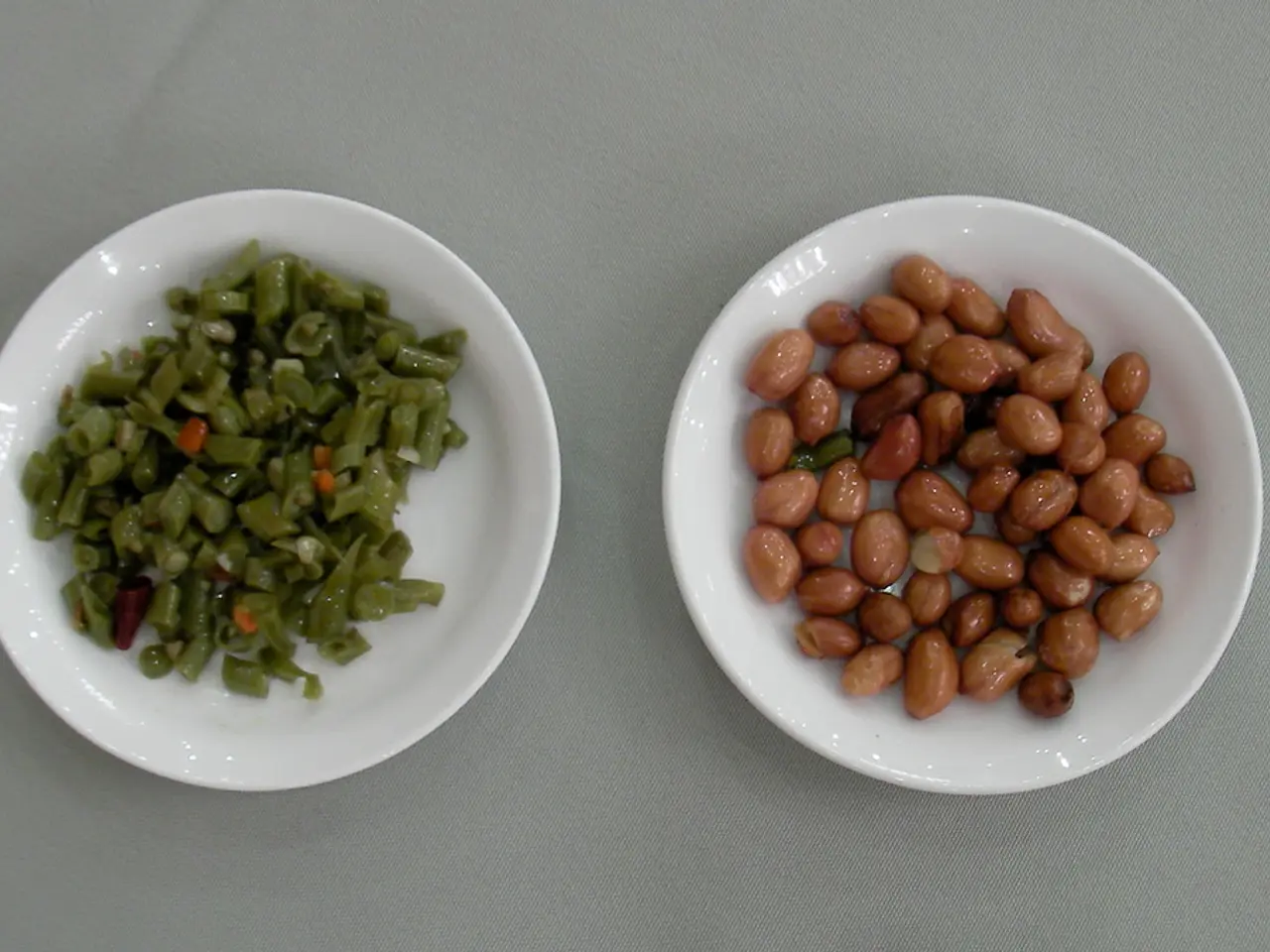Symptoms of peanut allergy in infants: What do they entail?
In a significant shift in advice, health authorities now recommend introducing peanut-containing foods to infants as early as 4 to 6 months of age, following the successful introduction of other solid foods [1][2][3][4]. This early and regular exposure (at least three times per week) can significantly reduce the risk of developing a peanut allergy.
This new guidance is based on strong evidence from landmark studies like the LEAP and LEAP Trio studies, which showed a reduction of up to 71–80% in peanut allergy rates when peanuts were introduced during infancy rather than delayed [1][3][4].
However, it's essential to remember that infants with severe eczema, an existing egg allergy, or both are at a higher risk of developing a peanut allergy. In such cases, seeking medical advice before introducing peanuts is crucial [1][5].
For parents, starting with peanut products safe for infants is advisable. This could be smooth peanut butter thinned with water or infant-safe peanut puffs, rather than whole peanuts, which pose a choking hazard [1][2].
It's also worth noting that eating peanuts during pregnancy or breastfeeding does not contribute to a peanut allergy in the baby, according to a recent study.
In case of an allergic reaction, immediate medical advice should be sought. Mild to moderate symptoms may include itchy or runny nose, sneezing, itchy mouth, hives, mild itching, mild nausea, and mild gut discomfort. However, severe symptoms may include shortness of breath or wheezing, difficulty breathing, difficulty swallowing, tight or hoarse throat, repetitive cough, weak pulse, dizziness, pale or blueish skin, a large quantity of hives, repetitive vomiting, diarrhea, significant swelling of the lips or tongue [1][5].
This updated approach replaces older advice to delay peanut exposure, recognising the short critical window in infancy when allergy prevention is most effective [1][2][3]. The goal is to help families navigate this important step in their child's dietary development with confidence and care.
[1] National Institute of Allergy and Infectious Diseases. (2020). Guidelines for the Prevention of Peanut Allergy in the United States. Retrieved from https://www.niaid.nih.gov/diseases-conditions/guidelines-prevention-peanut-allergy
[2] British Allergy Foundation. (2021). Peanut Allergy in Children. Retrieved from https://www.allergyuk.org/allergies/food-allergy/peanut-allergy
[3] Australian Society of Clinical Immunology and Allergy. (2021). Peanut Allergy. Retrieved from https://www.allergy.org.au/patients/food-allergy/peanut-allergy
[4] Lee, T. C. H., Jenkinson, S., Reynolds, A. P., Vickery, J. P., Lack, G., & Du Toit, G. (2019). Early peanut introduction in high-risk infants. The New England journal of medicine, 380(8), 781-791.
[5] American Academy of Pediatrics. (2017). Peanut Allergy Prevention Among High-Risk Infants. Pediatrics, 140(3), e20170366.
- A caregiver should be mindful of the new advice to introduce peanut-containing foods to infants as early as 4 to 6 months old to reduce the risk of developing a peanut allergy.
- The LEAP and LEAP Trio studies provided strong evidence for this new approach, showing a reduction in peanut allergy rates by up to 80% when peanuts were introduced during infancy.
- However, infants with severe eczema or an existing egg allergy, or both, have a higher risk of developing a peanut allergy, making it crucial to seek medical advice before introducing peanuts.
- For parents, using safe peanut products, such as smooth peanut butter or infant-safe peanut puffs, is advisable, while avoiding whole peanuts which pose a choking hazard.
- Eating peanuts during pregnancy or breastfeeding does not contribute to a peanut allergy in the baby, as confirmed by a recent study.
- In case of an allergic reaction, immediate medical attention is required, with mild to moderate symptoms including itchy or runny nose, sneezing, itchy mouth, hives, mild itching, mild nausea, and mild gut discomfort.
- Severe symptoms may include shortness of breath or wheezing, difficulty breathing, difficulty swallowing, tight or hoarse throat, repetitive cough, weak pulse, dizziness, pale or blueish skin, a large quantity of hives, repetitive vomiting, diarrhea, and significant swelling of the lips or tongue.
- This updated approach replaces older advice to delay peanut exposure, recognizing the short critical window in infancy when allergy prevention is most effective.
- The goal is to help families navigate this important step in their child's dietary development with confidence and care.
- It is essential for caregivers to educate themselves on chronic medical conditions such as chronic kidney disease, cancer, and neurological disorders that may require special attention in terms of health, eye health, hearing, fitness, mental health, skin care, nutrition, and healthy diets.
- Migraines are a common health issue affecting both adults and children, and it's important to manage them through appropriate means such as a healthy diet, fitness, and exercise.
- Psoriasis is a chronic skin condition that can benefit from proper skin care routines and possibly medical intervention.
- In terms of personal growth, education, and self-development, mindfulness practices, productivity strategies, career development, and online learning can contribute to goal setting, skills training, and job search.
- A balanced diet and regular exercise are crucial components of overall health and wellness, contributing to cardiovascular health, mental health, and helping to manage chronic diseases like diabetes and hypertension.
- Regular eye exams and hearing tests are vital for early detection and management of any issues that may affect eye-health and hearing.
- By staying informed about the latest medical research, understanding treatment options, and engaging in preventative measures, people can lead healthier, more fulfilling lives.
- Ultimately, caregivers play a vital role in promoting overall health and well-being in themselves and their loved ones through education, self-development, mindfulness, and a focus on health, fitness, mental health, nutrition, and skills training.






